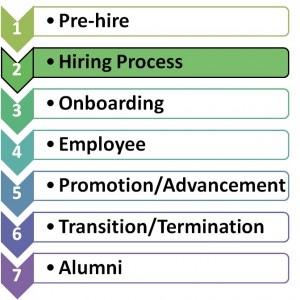 In the 7 Phases of Engagement, I proposed that each phase ties directly to the employee lifecycle and has the potential to impact the success of a company in terms of its ability to engage employees.
In the 7 Phases of Engagement, I proposed that each phase ties directly to the employee lifecycle and has the potential to impact the success of a company in terms of its ability to engage employees.
Today, we’ll look at the second phase of engagement: Hiring Process.
The Hiring Process phase builds on the Pre-hire phase and begins when a person applies for a role. What happens next will have an impact on the level of engagement the applicant will have with the company going forward. Let’s consider some of the aspects of the hiring process in more detail.
Available Company Information
Liz Ryan, in an article for Forbes says, “It’s easy to talk about talent on a website or in a recruiting brochure. It’s easy to say “We value talent more than anything! Talk is cheap. Attracting talented people into an organization and hanging onto them — now that’s another story.”1
How easy it is for an applicant to learn about your company? Your company website and its career section will be one of the first stops. How user-friendly are they? Additional sources of information could be annual reports, press releases, and articles on the company and its products. Social media sites such as your Facebook, LinkedIn, Twitter, and YouTube allow applicants to learn more about the company and its employees. The company should be active on these sites and interacting with friends, connections, followers, etc. in order to understand how the company is being perceived.
If the applicant is invited to interview in person, provide them with as much information as possible about logistics and what to expect once they arrive. Make it easy for the applicant to get to you. Provide directions, maps, parking/shuttle information, etc. Also, have someone dedicated to welcoming and hosting the applicant while they are in the office. Most of all, make sure those involved in the interview process are prepared for the applicant’s visit.
Job Description
The way in which you compose job descriptions is important. Most companies focus on the skills and experience needed to do a job. The job description includes everything including the kitchen sink for good measure. Lou Adler believes this approach is “anti-talent and anti-diversity, aside from being terrible predictors of future success.” He proposes a “performance-based job description [that] describes the work that a person needs to successfully accomplish during the first year on the job.”2 This requires preparation. Your company’s employee performance reviews could be a source of information to help you determine the associated performance objectives for the role.
Applicant Tracking System
The original purpose of the applicant tracking system was to better manage the application process. Have they gone too far? Information goes in, it is checked against a list of key words, and very little comes out. It’s a win for Human Resources (HR) since it reduces the number of applicants to a semi-manageable number. That would be great IF you were sure those were indeed the best applicants to pursue.
These systems depend on people entering their candidacy information. What about those potential applicants who give up on the process? The abandonment rate of your ATS can provide insight on the complexity and usability of the system.
Interviewing
If an applicant make it past the ATS, they often face three types of interviewers.
- The screening interview is usually delegated to the lower level or outsourced employees. They are given a list of questions and during a short telephone conversation they ask the applicant each of those questions. The problem is that the screener has no idea what the actual role entails and is unable to understand the context of the questions they are asking. Yet, they are given the power to remove applicants from the.
- HR interviews aren’t much better than the screening interview. These interviewers may have a better understanding of the company but many still have no idea of what the role entails.
- The last type of interviewer is the hiring manager. While these interviewers have an understanding of and context around the role, most are not trained in interviewing techniques. Interviewing is just another task they must “fit in” to their normal schedule.
If companies expect applicants to come prepared, they should be prepared themselves. Interview training should be incorporated into the process so that each interviewer can more effectively move the process forward without disengaging applicants.
As for the interviews themselves, companies should determine the number and types of interviews. Some companies, such as Google, have learned that there is a point of diminishing returns when it comes to the number of interviews.3 By reducing the number of interviews, current employees are freed focus on other tasks.
Interview best practice: Zero in on what you want to discuss in the interview and let the applicant know ahead of time. This will help focus the interview and result in a more productive meeting.
To determine the effectiveness of the interviews, consider the retention statistics for new hires. Are employees are leaving soon after they were hired? If so, the hiring process did not set the appropriate expectations. Analyze the data and make changes to the process. Perhaps one solution would be to allow the applicant shadow a current employee so they can see firsthand what to expect.
Testing
Some companies require applicants to take a battery of tests: personality tests, skills tests, etc. If the company has statistics that prove these tests are predictors of performance, then they can be justified. If these tests are just another screening method, consider a better use of your resources. For tests that are performed, make sure the applicant is informed of the results. By allowing the process to be a development opportunity, you can create good will with the applicants regardless of whether they continue in the process or not.
Referrals
Referrals can be an important source of potential applicants. Actively managing the referral process is fundamental to the engagement of the referring employee. Referring employees should understand the referral system and be kept up-to-date on the status of any referred applicants as they progress through the hiring process.
Formal hiring process
As explained above, there are many factors that comprise the hiring process. Does your company have a formal process established? If followed, a formal process will allow you to evaluate each applicant equally.
Without a formal hiring process, potential biases could impact the hiring decision. There are applicants that interview well, have impressive resumes, and/or provide strong references. The selection criteria and its associated weighting should be established prior to any interviews being conducted. This will help focus all interviewers on what is important to learn about each applicant.
In order improve the hiring process, collect as much information as possible, commit to analyzing it, and then incorporate changes as needed.
The hiring process requires resources in terms of time and money. Make sure that it is well spent and moves the company closer to finding the right candidate for the role and engages potential applicants in the process.
1 Ryan, Liz. “10 Ways Companies Drive Away Talent.” Forbes.com. 1 Feb. 2014. Web. 24 Mar. 2014.
2 Adler, Lou. “Ban Job Descriptions and Hire Better People.” Ere.com. 13 Feb 2013. Web. 24 Mar. 2014.
3 Mochari, Ilan. “3 Ways to Revamp Your HR Department Using Data.” Inc.com. 24 Mar 2014. Web. 24 Mar. 2014
P.S. First time here? Welcome to the Agent In Engagement site. Thanks for taking the time to stop by! I hope you’ll explore the rest of the site. Let me know what employee engagement topics interest you.
If you enjoyed this article, you may also like…
- Pre-hire: The First Phase of Engagement
- 7 Phases of Engagement
- Take the Day On – March Forth!
- Engaging Through The Infographic
- Just Say Hello!
- Naches and Employee Engagement
Let’s Get Engaged!
I’m Agent in Engagement Simpson…Gregory F Simpson.
I’m excited about this opportunity to connect with fellow “Agents.” Subscribe to the RSS Feed to receive the latest updates and/or register to comment on posts.
 You can follow me @agtinengagement.
You can follow me @agtinengagement.
Email me at g…@a…t.com.
Learn more about me at www.gregoryfsimpson.com.
